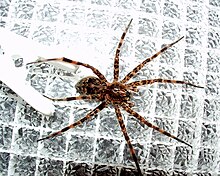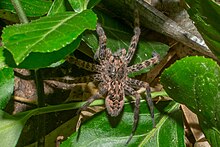| Dark fishing spider | |
|---|---|

| |
| Scientific classification | |
| Domain: | Eukaryota |
| Kingdom: | Animalia |
| Phylum: | Arthropoda |
| Subphylum: | Chelicerata |
| Class: | Arachnida |
| Order: | Araneae |
| Infraorder: | Araneomorphae |
| Family: | Pisauridae |
| Genus: | Dolomedes |
| Species: | D. tenebrosus
|
| Binomial name | |
| Dolomedes tenebrosus | |
| Synonyms | |
| |
Dolomedes tenebrosus or dark fishing spider is a fishing spider found in the United States and Canada.[1][2]
It is able to bite humans but will run from people. In most cases, the bite is no more severe than a bee or wasp sting.[3]

